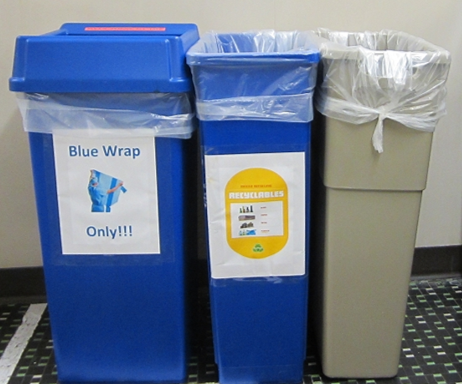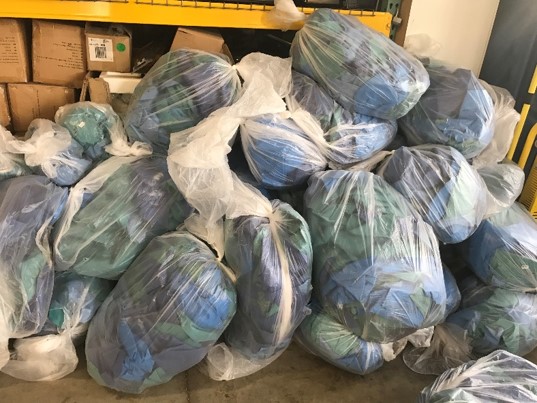How Getting Staff Involved and Engaged and Leveraging Local Resources Led to Success
HealthPartners is an award-winning integrated health care system based in Bloomington, Minnesota and is the largest consumer-governed, nonprofit health care organization in the nation. HealthPartners serves more than 1.5 million medical and dental health plan members nationwide, more than 1.2 million patients, and is a top-ranked commercial plan in Minnesota. A team of 22,500 employees is dedicated to a mission to improve the health and well-being of members, patients and the community.
Sustainability is an important part of that mission, and the organization is committed to providing a healthier and cleaner community for the people they serve, and future generations. Recycling has always been part of HealthPartners’ culture and values, but the program was expanded and formalized about five years ago to incorporate additional streams and educational support for staff. The goal is to divert as much as possible from waste streams, including all types of plastic from all areas of the hospitals and facilities. In 2016 alone, HealthPartners kept 3,919 tons of material out of the landfills by recycling 23 tons of blue wrap, 1,300 tons of single-stream materials, and donating 55 tons of medical supplies, equipment, and office furniture.
So, how do they do it? Let’s look at three tactics the team used that might work at your hospital.
People Power
One of the biggest drivers of HealthPartners’ success is the investment their employees have in their recycling program, which is no accident. The sustainability team (led by Dana Slade, Director of Sustainable Programs, Barb Tretheway, Senior Vice President and Legal Counsel for HealthPartners and Executive Champion, and Samantha McKeough, Sustainability Coordinator) has worked hard to include many different groups of stakeholders and allow numerous opportunities for staff involvement and input in the process.
The sustainability program as a whole is driven by a team of five Executive Sponsors who meet on a quarterly basis, and by a Sustainability Steering Committee, which meets on a monthly basis. The Steering Committee is made up of nominated representatives from leadership who ensure that each of the various roles within healthcare are represented (including pharmacy, clinics, specialty centers, all six hospitals, real estate, facilities and operations, human resources, information technology, data center, community relations/well-being programs, administration facilities, nutrition, and more). Together, these two groups oversee all local Green Teams, work groups, and the sustainability department work plan and have been instrumental in developing the organization’s Sustainability 2020 goals and strategic plan.
HealthPartners has been fortunate to have passionate internal champions (including OR staff), who are always looking for ways to expand the program even further, but the team’s advice for anyone facing an uphill battle in this area is “Be patient…but not hesitant.” In particular, connecting your program with your organization’s mission can greatly increase employee engagement and participation.

Learning, Doing, then Learning Some More
Once your staff are onboard with your mission, the next hurdle is getting everyone on the same page about how to execute the program. HealthPartners does this via extensive and varied training. By communicating with people regularly and via lots of different channels, they ensure that their message reaches everyone and truly resonates.
A few of the channels the sustainability team uses at HealthPartners include in-person site visits and team meetings, participation in daily hospital huddles, live sort events, newsletter articles, PowerPoint trainings, labels and decals for recyclable materials, and even an interactive recycling sort game. The game consists of photos of standard recycling and trash containers as well as photos of items that are most typically generated at HealthPartners facilities–at employee events and Green Team tables, folks are given photos of hospital materials that they then have to match with the correct container.
One of the most comprehensive communication tools is the Sustainability Guidebook, an annual guide that includes recycling program context and goals, waste breakdowns, photos of recyclable items, FAQs, and strategies for recycling different material types. The guide is available to all employees on the HealthPartners intranet and via email to anyone who reaches out to the department with questions. A copy is also made available at all Green Team and employee events, and Green Team members keep copies in all break rooms, staff lounges, coffee station areas, and above waste and recycling containers. Basically, there’s no way for staff to miss it!
Local Matters
Based in Minnesota, HealthPartners is fortunate to be in a location where state and county government are supportive of sustainability efforts, which has certainly sped up progress. Through various grants and other programs, HealthPartners has been able to make over $100,000 in program improvements, including the purchase of new recycling containers and three new compactors, and to assist with the implementation of organics recycling at the Park Nicollet Methodist Hospital in Saint Louis Park, MN. While being in a less-supportive area doesn’t mean doom for your program, it is worthwhile to do some digging and make sure you are taking advantage of any and all programs that are available.

Another way HealthPartners plugs in to the community, to mutual benefit, is by partnering with Merrick, Inc. Based in St. Paul, Merrick’s mission is to empower adults with disabilities through vocational and social opportunities; for HealthPartners, this means that Merrick collects shrink wrap and blue wrap, then bales, stores, and prepares it for market, something neither HealthPartners nor their co-mingle recycling/trash hauler has the bandwidth to do internally. We’ve seen other hospital systems find success through similar partnerships with organizations such as Goodwill, and they can be a great win-win-win scenario.
Dream Big
While your system may not be as large or complex as HealthPartners, by making sure your employees are plugged in to the process, reinforcing your sustainability program and goals in as many ways as you can, and tailoring your program to your local resources, you too can build a lasting and successful healthcare recycling program.
To learn more, visit the HealthPartners sustainability page or contact the department directly at HPSustainability@HealthPartners.com. See their slides from the event here.

